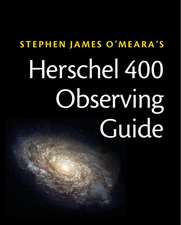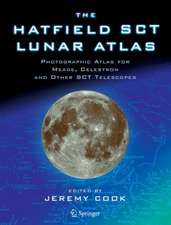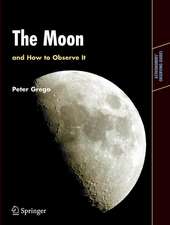Nebulae and How to Observe Them: Astronomers' Observing Guides
Autor Steven Coeen Limba Engleză Paperback – 28 dec 2006
Nebulae are the places where the stars are born. For amateur astronomers, the many different kinds of nebulae vary from "easy" targets that can be seen with modest equipment under mediocre skies, to "challenging" objects that require experienced observers, large telescopes and excellent seeing.
The concept of the book - and of the series - is to present an up-to-date detailed description and categorisation (part one); and then (part two) to consider how best to successfully observe and record the large range of astronomical objects that fall under the general heading of "nebulae".
Nebulae and How to Observe Them is a mine of information for all levels of amateur observers, from the beginner to the experienced.
Din seria Astronomers' Observing Guides
-
 Preț: 196.41 lei
Preț: 196.41 lei -
 Preț: 189.37 lei
Preț: 189.37 lei -
 Preț: 193.12 lei
Preț: 193.12 lei -
 Preț: 184.28 lei
Preț: 184.28 lei -
 Preț: 329.89 lei
Preț: 329.89 lei -
 Preț: 273.58 lei
Preț: 273.58 lei -
 Preț: 275.79 lei
Preț: 275.79 lei -
 Preț: 280.19 lei
Preț: 280.19 lei -
 Preț: 254.46 lei
Preț: 254.46 lei -
 Preț: 251.37 lei
Preț: 251.37 lei -
 Preț: 285.68 lei
Preț: 285.68 lei -
 Preț: 213.79 lei
Preț: 213.79 lei -
 Preț: 254.90 lei
Preț: 254.90 lei -
 Preț: 298.02 lei
Preț: 298.02 lei -
 Preț: 217.51 lei
Preț: 217.51 lei -
 Preț: 300.37 lei
Preț: 300.37 lei -
 Preț: 270.70 lei
Preț: 270.70 lei -
 Preț: 345.09 lei
Preț: 345.09 lei -
 Preț: 342.13 lei
Preț: 342.13 lei -
 Preț: 246.30 lei
Preț: 246.30 lei -
 Preț: 256.78 lei
Preț: 256.78 lei -
 Preț: 210.90 lei
Preț: 210.90 lei
Preț: 183.23 lei
Nou
Puncte Express: 275
Preț estimativ în valută:
35.06€ • 36.61$ • 29.02£
35.06€ • 36.61$ • 29.02£
Carte disponibilă
Livrare economică 14-28 martie
Preluare comenzi: 021 569.72.76
Specificații
ISBN-13: 9781846284823
ISBN-10: 1846284821
Pagini: 168
Ilustrații: IX, 156 p.
Dimensiuni: 178 x 254 x 10 mm
Greutate: 0.34 kg
Ediția:2007
Editura: SPRINGER LONDON
Colecția Springer
Seria Astronomers' Observing Guides
Locul publicării:London, United Kingdom
ISBN-10: 1846284821
Pagini: 168
Ilustrații: IX, 156 p.
Dimensiuni: 178 x 254 x 10 mm
Greutate: 0.34 kg
Ediția:2007
Editura: SPRINGER LONDON
Colecția Springer
Seria Astronomers' Observing Guides
Locul publicării:London, United Kingdom
Public țintă
Adult: GeneralCuprins
Introduction. PART 1- 1. Star Formation and Composition – the ingredients of Nebulae.- 2. The Milky Way – our Galaxy and Home to Nebulae - Emission Nebulae - Reflection Nebulae - Dark Nebulae - Planetary Nebulae - Supernova Remnants - Extragalactic nebulae? PART 2- 3. Instruments - naked eye, binoculars, RFT, Mak/SCT, Dobsonians.- 4. Techniques - Dark adapation, red light, averted vision.- 5. Accessories - eyepieces, filters, finders.- 6. Locating objects – setting circles, star hopping, ‘goto’.- 7. Resources - finder charts, computer-based planetaria, deep-sky books, the Internet.- 8 Observing Guide - planning, conditions and weather, seeing and transparency, atmosphere, logging.-
9. Observing lists. Catalogues of nebulae – general: NGC/IC, Messier; Gaseous: Lynds; Planetaries: P+K, Strasbourg; Dark: Barnard, Lynds
9. Observing lists. Catalogues of nebulae – general: NGC/IC, Messier; Gaseous: Lynds; Planetaries: P+K, Strasbourg; Dark: Barnard, Lynds
Recenzii
From the reviews:
"If you’re a beginning or intermediate observer, and if you’re interested in observing nebulae, this is a book you should check out. I like the book for many reasons. Coe writes in a conversational tone. … Coe’s book works as an advanced checklist, but with lots of highly valuable notes." (Michael Bakich, www.astronomy.com, December, 2006)
"This slim volume is part of Springer’s Astronomers’ Observing Guides series which is aimed at more-advanced amateur astronomers. … the first 42 pages are taken up with fairly basic information on how to select an observing site. … The second section of the book describes some of the author’s favourite nebulae arranged by observing season. … for beginners who want a basic guide to observing nebulae the book will have a few good tips and a list of targets for them to track down." (Owen Brazell, The Observatory, Vol. 127 (1200), October, 2007)
"Coe has written an excellent how-to guide based on his years of observing nebulae in dark locations, mostly in the deserts of the western US. This volume is one in a series of "Astronomers’ Observing Guides’ intended for serious amateur astronomers. … Helpful tips include the use of planetarium software and advice on how to dress warmly. … An appendix lists hundreds of nebulae with catalog number, coordinates, and brief observing notes. Summing Up: Highly recommended. General readers." (M. Dickinson, CHOICE, Vol. 44 (11), July, 2007)
"This book, by S.R. Coe, is published in the series Astronomers’ Observing guides and provides an up-to-date information to the amateur astronomers who want to know all about what they are observing. The objectives and the scope of this book are thus clear … . An appendix contains a listing of a wide variety of nebulae across the entire sky." (Emile Biemont, Physicalia Magazine, Vol. 29 (4), 2007)
"If you’re a beginning or intermediate observer, and if you’re interested in observing nebulae, this is a book you should check out. I like the book for many reasons. Coe writes in a conversational tone. … Coe’s book works as an advanced checklist, but with lots of highly valuable notes." (Michael Bakich, www.astronomy.com, December, 2006)
"This slim volume is part of Springer’s Astronomers’ Observing Guides series which is aimed at more-advanced amateur astronomers. … the first 42 pages are taken up with fairly basic information on how to select an observing site. … The second section of the book describes some of the author’s favourite nebulae arranged by observing season. … for beginners who want a basic guide to observing nebulae the book will have a few good tips and a list of targets for them to track down." (Owen Brazell, The Observatory, Vol. 127 (1200), October, 2007)
"Coe has written an excellent how-to guide based on his years of observing nebulae in dark locations, mostly in the deserts of the western US. This volume is one in a series of "Astronomers’ Observing Guides’ intended for serious amateur astronomers. … Helpful tips include the use of planetarium software and advice on how to dress warmly. … An appendix lists hundreds of nebulae with catalog number, coordinates, and brief observing notes. Summing Up: Highly recommended. General readers." (M. Dickinson, CHOICE, Vol. 44 (11), July, 2007)
"This book, by S.R. Coe, is published in the series Astronomers’ Observing guides and provides an up-to-date information to the amateur astronomers who want to know all about what they are observing. The objectives and the scope of this book are thus clear … . An appendix contains a listing of a wide variety of nebulae across the entire sky." (Emile Biemont, Physicalia Magazine, Vol. 29 (4), 2007)
Textul de pe ultima copertă
Nebulae are the places where the stars are born. They can also be opaque clouds of dust that block our view of the stars beyond, starlight reflecting on cosmic dust clouds, or hot luminous expanding gases left over from a supernova explosion. Any description of this class of celestial object is… well… nebulous.
And yet this broad category contains the most fascinating and beautiful objects in the night sky. Some are easy to see, while others challenge the most experienced observers.
Nebulae and How to Observe Them presents an up-to-date detailed description and categorization of nebulae (part one); and then (part two) describes in practical terms how best to successfully observe and record them.
This book is a mine of information for all levels of amateur astronomy, from relative beginners to experienced observers. In one book, here is all you need to understand and observe those diverse and beautiful objects that fall under the heading of ‘nebulae’.
And yet this broad category contains the most fascinating and beautiful objects in the night sky. Some are easy to see, while others challenge the most experienced observers.
Nebulae and How to Observe Them presents an up-to-date detailed description and categorization of nebulae (part one); and then (part two) describes in practical terms how best to successfully observe and record them.
This book is a mine of information for all levels of amateur astronomy, from relative beginners to experienced observers. In one book, here is all you need to understand and observe those diverse and beautiful objects that fall under the heading of ‘nebulae’.
Caracteristici
In two parts: (i) a modern comprehensive review of the formation and morphology of the nebulae, and (ii) observing techniques for amateur astronomers The very latest detailed theories and physical descriptions for each category of nebula Discusses high-energy satellite data and new object discoveries Detailed information about how to observe and record the different classes of nebulae using a variety of instruments of different sizes













